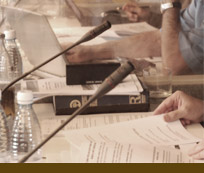


Our services explained
Modes of interpreting.
Simultaneous interpretation
Conference interpreting occurs almost exclusively in simultaneous interpretation mode, where interpreters sit in a sound-proof booth, speak into a microphone and the audience listens to the interpreted speech via earphones.
Simultaneous interpretation is carried out by at least two interpreters, usually two per working language. They work in shifts of 20-30 minutes.
In simultaneous interpreting, the interpreter mainly interprets into his/her first language (language ‘A’) from one or more of his/her other languages (language ‘B’ and ‘C’). If required, the interpreter works into his/her ‘B’ language (a language other than his/her native language and of which she/he has a perfect command). Recourse to “retour”, or bi-active interpretation, is often unavoidable in the case of many minority languages. C-language is a language of which the interpreter has a complete understanding and from which she/he works.
“Whispered” interpreting (known as “chuchotage” in French) is used in small groups or workshops. Normally, the interpreter works closely with a small target-language audience (usually, no more than two people) whilst “whispering” a simultaneous interpretation of the source message.
Consecutive interpreting
In consecutive interpreting, the interpreter speaks after the source-language speaker. The speaker divides his/her speech into segments and pauses in order to allow the interpreter to convey the message to the target language audience. This method can be used in small meetings, such as negotiations, and is generally combined with “whispered” interpreting. The interpreter “whispers” the source language simultaneously and will return to consecutive interpreting when his/her client takes the floor.
During group visits or delegations to work places, for instance, interpreters use a portable piece of equipment called a “bidule”, which allows “whispering” simultaneously into a microphone whilst the audience listens to interpretation via earphones.
We offer high quality translation services. All our translators are native speakers.
Our translation services are used by a wide-range of organisations, including cultural institutions, the tourist and hotel industry, local, regional and central government councils and administration, publicity agencies, the forestry industry and IT companies.





